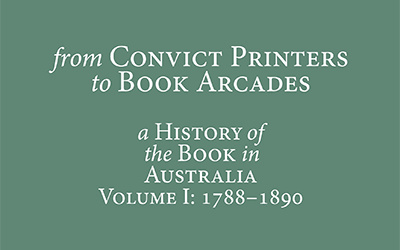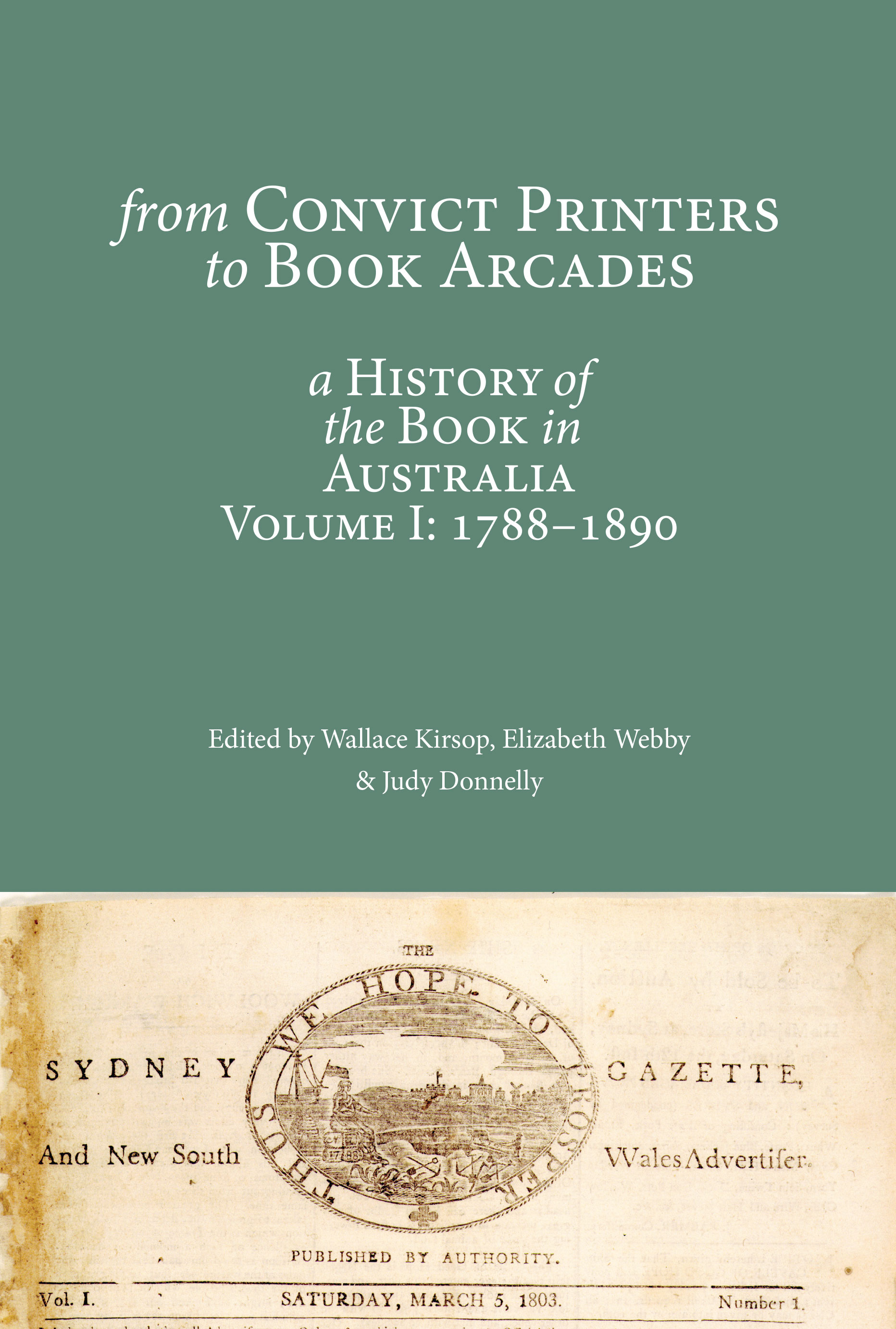
- Free Article: No
- Contents Category: Book History
- Review Article: Yes
- Article Title: Tympan and frisket
- Article Subtitle: The book in our society
- Online Only: No
- Custom Highlight Text:
The three-volume History of the Book in Australia is now complete. Scholars of Australian book history would be aware that an earlier volume, covering 1891–1945, appeared in 2001 (A National Culture in a Colonised Market, edited by Martyn Lyons and John Arnold) and that in 2006 a second volume brought the story up to 2005 (Paper Empires, edited by Craig Munro and Robyn Sheahan-Bright). Both titles were published by the University of Queensland Press. The end of that publisher’s capacity to support the project, with Australian Research Council funds long gone, is one challenge among others cited by co-editor Wallace Kirsop that sheds light on the long gestation of this final volume. The last to be published, it is in fact the first in the History’s series, covering the period 1788 to 1890.
- Featured Image (400px * 250px):

- Alt Tag (Featured Image): Nathan Hollier reviews ‘From Convict Printers to Book Arcades: A history of the book in Australia, Volume I: 1788-1890’ edited by Wallace Kirsop, Elizabeth Webby, and Judy Donnelly
- Book 1 Title: From Convict Printers to Book Arcades
- Book 1 Subtitle: A history of the book in Australia, Volume I: 1788-1890
- Book 1 Biblio: Ancora Press, $50 hb, 540 pp
- Book 1 Cover Small (400 x 600):

- Book 1 Cover (800 x 1200):

- Book 1 Readings Link: https://www.readings.com.au/product/9780648738541/the-history-of-the-book-volume-1--2025--9780648738541#rac:jokjjzr6ly9m
Kirsop records in the Introduction that the decision to undertake this History dates to a meeting of bibliographers and historians at the University of New South Wales in 1992, but it might be remembered that Kirsop’s booklet Towards a History of the Australian Book Trade was published in 1969 and that he first called for a history of the book in Australia in 1963. A major figure in French studies, as well as in book-trade history, Kirsop has over more than six decades pursued an Australian version of the French Annales School histoire totale exemplified in L’ Apparation du Livre, by Lucien Febvre and Henri-Jean Martin (1958), released in English as The Coming of the Book: The impact of printing 1450–1800 in 1976.
In 1994, in the Bibliographical Society of Australia and New Zealand Bulletin, Kirsop set out that ‘[w]hat is important is to recognise that authors, publishers, printers, wholesale and retail booksellers, binders, travellers, runners, chapmen and all the other members of the trade and of its clientele belong to a system, to a structure whose changes over time have to be understood. The book historian has to go all the way from a work’s gestation to its ingestion by individual and identifiable readers.’ This was a grand vision. The Australian History of the Book, Kirsop notes here, emphasises in its title ‘an indefinite article that speaks of a modest and provisional stance’. This volume is ‘a leisurely and yet summary overview of a critical part of Australian literary, intellectual and social history’.
Kirsop’s acknowledgment of the project’s modesty, alongside its ambition, is wise, for the first century of European-Australian book history is not for the faint-hearted. Several chapters begin like Thomas Darragh’s on ‘Illustrations’: ‘During the nineteenth century the market for books printed in Australia was relatively small.’
While admirable, perhaps, in its directness, such a beginning does rather take the wind from the reader’s sails as she casts her eye forward wonderingly to the chapter’s pages ahead. There is no hiding from the fact that the History is first and foremost a reference work for scholars, or seriously committed book enthusiasts; thus Stephen Herrin alerts us to the fact that the cylinder-press ‘retained the tympan and frisket of hand-presses but mechanised the rest of the process with a reciprocating bed, a platen that provided a downward force through the use of a toggle joint and automatic inking’.
However, numerous contributions illuminate larger dynamics by identifying how books have been created, and/or used, for and with particular social purposes and effects. The late Penny van Toorn shows how ‘in ex-colonial societies, Indigenous and non-Indigenous cultures have become entangled in complex ways’. She identifies ‘evidence to suggest that Indigenous and non-Indigenous societies saw the other’s communication technologies as analogous to their own’ and sees patterns ‘of Aboriginal book history … in the tendency to work collaboratively, in the wariness towards books and writing as technologies of an alien power, in the practice of textually positioning readers as physically present to the author, and in the use of books and writing as a means of carrying stories from one (actual or imagined) context of oral enunciation to another’.
Raelene Frances reveals the crucial role of gender politics within Australian print work, including a ‘“line of demarcation” between highly paid, male work and poorly paid, female work … rigidly maintained by the male craftsmen’ for whom ‘the spectre of female labour … represented a threat to the whole culture of the workplace and their sense of masculinity’. The late Elizabeth Webby brings her strong expertise and erudition to discussions of authorship and readership during the colonial period, as well as to magazine publishing. She shows how economic, cultural, technological, and legal factors within the industry interacted to produce some outcomes that we may not have anticipated, including that almost all Australian book publication before 1890 was done at the author’s expense, and others that have contemporary implications we may not have fully registered, including the long-term trend away from the intensive reading of a few books to extensive reading of a variety of content, evident already in the nineteenth century.
Clive Turner usefully shows the mechanics of copyright legislation and its effects on Australian authors. Kirsop makes a palpable contribution to our understanding of colonial Australian bookselling in the context of shifting legislative and trade approaches to industry regulation. David Jones provides a valuable account of the establishment, practice, and underlying humanist philosophy of colonial libraries, with the powerful personality of Redmond Barry looming large. Maureen Perkins writes on the enormously popular colonial almanacs, or literary calendars, which in their foregrounding of rational knowledge, colonial life, and ‘useful facts’ were distinctively Australian. Susan Woodburn compares the success of energetic Melanesian- and Polynesian-language Christian texts with the pronounced failure of such publishing aimed at Aboriginal audiences.
Kirsop ends with a challenge: ‘Can a future generation turn our tentative essays into solid foundations?’ Future researchers on the book in Australia owe Kirsop, Webby, Donnelly, and their colleagues across these three volumes a great debt, and contributors to this volume have greatly helped to fill out the picture of the book in Australia: ‘By the end of the first century of European occupation,’ as Kirsop writes, ‘a Western-style book industry had been effectively established.’ The authors show throughout a sensitivity to the local character of the different colonies in an approach which may prove influential for future scholarship. In its publishing, bookselling, state library, secular approach to education, mechanics institutes, and even world-first steam powered lithographic map production, Melbourne emerges strongly as, in Webby’s words, ‘the largest Australian literary centre in the second half of the century’. Intriguingly, if ‘[t]he story of publishing in Australia in the opening decades of the nineteenth century is largely the story of George Howe’, as Ian Morrison suggests in his rich account of ‘The Beginnings of Australian Publishing’, the story can be seen to be from the outset connected to the British slave trade and its legacies, for this early government printer was born in St Kitts to the daughter of ‘a plantation owner’.
Nonetheless, Kirsop is right to suggest the need for more thought to be given to the place of the book in our society. As books and art do not merely reflect our world but also help to bring it into being, the place and role of the book at any time tells us as much about a society – its health and priorities – as about the book itself, whatever its physical or virtual shape or form.


Comments powered by CComment